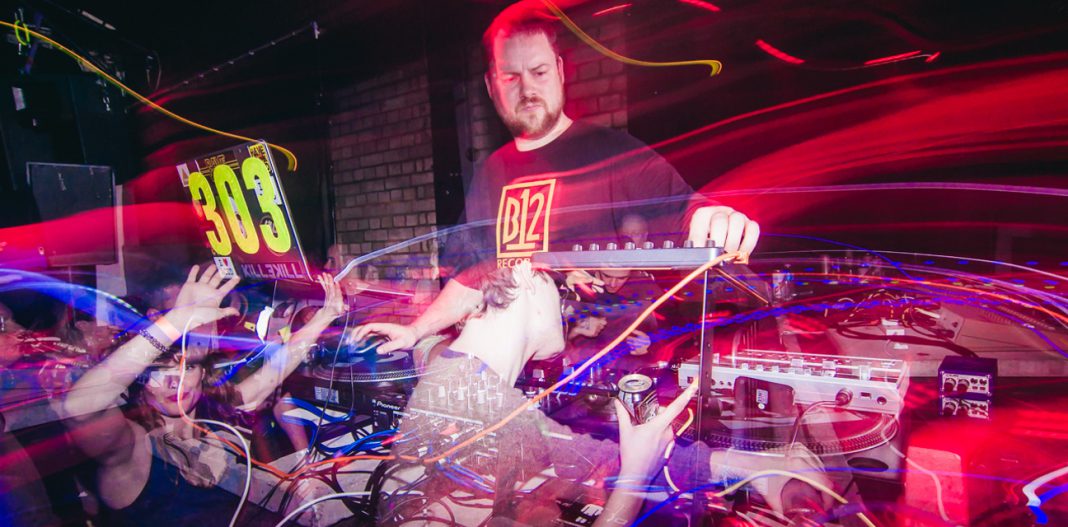Photo: Press (Posthuman)
“I think this is going to be our busiest year yet,” says Joshu Doherty about his work with Posthuman, the Balkan label and its already-iconic I Love Acid series and in a way, that is hard to imagine. Together with his cousin Richard Bevan (most likely not related to a certain William), Doherty has been constantly releasing music, playing live and DJing as Posthuman while throwing the I Love Acid parties all over the UK and beyond, helping out with B12’s eponymous while sometimes joining forces with legendary hardcore outfit Altern-8 or performing as AGT Rave Cru. It’s close to incomprehensible how anyone would be able to fit that into only one life, let alone doing even more than just that in the near future. Additionally, Doherty even found the time to record a mix for our Groove podcast’s March 30th – geddit? – issue and sit down with us to talk, all things Acid.
There are different approaches to categorising Acid – some more puristic than others. What’s your definition of Acid?
I think Acid is about one of the broadest terms you can get within dance music. It’s both a sound and a genre, but also kinda relates to a moment in time and one of the last big social movements in music. Obviously, at the core of it is Acid – the sound of the Roland TB-303. It has such a unique twisted signature, and the way the sequencer works is pretty unique. It’s taken decades for anything to come close to replicating the exact sound – but anything that has that kind of tweaking is often referred to as Acid – be it a 101, Moog, etc. When Phuture wrote “Acid Trax” they said it was like there was Acid in the circuits, dissolving the synthesizer from inside. That name stuck, and with the help of Ron Hardy really became a touchstone. But when that Acid sound, over Chicago House music, found its way across the Atlantic and into the clubs of the UK, it arrived at a moment of perfect storm, with the rave movement. Like Punk, Rock, Northern Soul etc. before it – this was a music that connected with a specific youth movement, a change in direction for people. The fact it was called “Acid” was jumped upon by a very ignorant public, via the press and police – thinking it had something to do with LSD – and it just ran and ran. So: Acid House doesn’t even need to be TB-303-led music, just anything from that era that signifies the kind of feeling and vibe of the early rave music: jacking Chicago stuff, Hip House, Sheffield bleepy Techno… It can all be referred to as Acid music to some degree. And onwards from that, the TB-303 has found its way into every genre. Ambient, breaks, Trance, Jungle… Then onto even Rock, Metal, Dubstep, Grime. It’s as universal as the amen break. So anything can be “Acid” when you add the right kind of bassline! For me though, it’s the sound of the silver box (or its closest relations), regardless of what you layer it on.
How did you first come in touch with Acid and what drew you to it? You’ve started throwing Acid- and IDM-themed parties and releasing records near the turn of the century. How was the scene like back then?
For me, it was the late 90s electronica and weirdo approach to acid that came first. The likes of Luke Vibert, Aphex Twin were really where I came into it. From there, Rich (my cousin, and part-time one half of Posthuman) introduced me to Plastikman and Underground Resistance, I guess – late 1990s-ish. I didn’t actually own a 303 for a long time, though I borrowed and sampled other people’s! Pre-internet, even though they were still cheap (£400-ish) they were actually quite hard to get hold of. Also, I was young and broke! While acid was a fixture of our crew and scene – Ardisson, for example, the first artist we ever signed to our first label Seed (circa 2000) was a great Acid producer – most of our parties (Tube station bashes from 2001-04, then the Soviet parties at the Coronet) were more musically mixed. The London IDM scene in the late 90s and early 2000s was much more experimental and less genre-based than it is now. People were a bit more daring to find out new things. This might be partly due to London still being cheap enough for young people to rent: these days, less kids head to the city from elsewhere unless they have deep pockets, and that doesn’t lead to as much creatively interesting. The local kids are still doing it – see the explosion of grime in the last decade – but very few out-of-towners (like we were) are coming in and building new scenes. It wasn’t until 2007 that I left Seed Records and stopped putting on those kind of IDM events anymore. I spoke with Luke Vibert about doing a one-off track based around his track “I Love Acid” with him, us, and a bunch of mates playing. It was a success, so we did another… And another, and on that went until suddenly it’s 11 years later, and I think at last count just over 120 events in 15 different cities. The label came about 4 years later and is now selling out every release very fast (last one, Jared Wilson, sold out in 90 minutes). None of it was planned, but the best things never are! The scene is different now – much more mixed age groups, it’s normal to see 18 and 50 year olds dancing in the same crowd, that wasn’t really a thing 15-20 years ago. People are a lot more knowledgeable now, though I’d say on the flipside to that – a little less daring and perhaps higher expectations. I Love Acid has a proper lovely, loyal following – I’d say there’s at least a couple hundred people in London who I see regularly and know by name that have been with us for years. This always makes for a really good vibe, more like a house party. I’ve actually downsized the London residence (from 550 capacity event to 200) because that intimate atmosphere is the most important thing.
A few years ago, Acid saw another revival with both unsung heroes and new faces receiving a lot of attention. How did you perceive said revival as someone who’s dedicated about two decades and more of his life to the scene?
There are a lot of crews who have been keeping acid alive for years – Society were running before us in London, as were Bangface. In the Netherlands you have 030303, in Berlin there’s Killekill, De:Tuned in Belgium, Tripalium in France, the likes of Polybius Trax and Classicworks in Barcelona. We were all doing our thing before acid became fashionable again and for sure will be if and when it fades from the mainstream eye. A lot of people started discovering 303s again and doing new things with them, which meant there was plenty of new music to play. Nothing wrong with that in a million years! It’s nice seeing guys like Paranoid London picking up their due respect – those guys were around for years and are the real deal. As for acts jumping on the bandwagon – it’d be rude to name them but those who know – know. (laughs) One real effect though, quite a few DJs became more expensive to book as they were more in demand than they had been for a while.
Since 2000, you’ve put out about a dozen full-length releases and more than twice as many EPs under the Posthuman moniker alone, two new releases on Chiwax and Shipwrec are currently under way. What does your working process have to be like in order to be so prolific?
To be honest – I think we’d like to write a lot more than we do, but adult life gets in the way. Both Rich and I have kids, he’s an architect and most of my time is eaten up by running the label and events. Right now, we’re struggling with more requests for tracks and remixes coming in than we have time to write. Our working process has always been the same though: We get drunk and write jams. That’s the fun bit, and ideas can flow quickly. Then we come back to them later and refine them into tracks, which is more boring and time-consuming. We’re still pretty simple with our approach technically. We like hardware, and we’ve been using the same software (FL Studio) for years – prefer not to both with updates, better to know your system inside-out than constantly be spending your time learning what’s changed. Restrictions are good for creativity, you find new ways of doing things. I even miss the days before computers, recording down to a 4-track using drum machines for sequencers, guitar pedals for FX and a tape player with a pause button as a sampler.
You’ve been working a lot with producer and vocalist Josh Caffé recently. What characterises your working relationship?
We’re friends, drinking buddies, and occasionally we gig together and write music! We met in the pub via Jon Dasilva, when we were both on the same booking agency, and just hit it off. Josh pops round to my studio every now and then to record vocals, but more often than not the two of us will just be out partying – usually with Quinn from Paranoid London in tow. He’s great to have along on the mic when we do gigs, really rocks out a great sleazy Jamie Principle vibe. Most of our shows together are great – although we had a messy one for Boiler Room last year. The stage was set up bang in the middle of a big venue, full crowd, with the main soundsystem on – we couldn’t use the monitors or hear his microphone (for obvious feedback reasons) so he was singing blind, and we were playing without being able to hear him or check if our two 303s were in tune. Note to self: Don’t do a live show from the middle of the room!
Somewhat unsurprisingly, your March 30th mix is quite Acid-heavy, including some cuts by DJ Pierre the queercore outfit Limp Wrist. What was your idea behind it?
Honestly – unplanned. I never really plan my sets – I might have one or two tracks that go well together. Even when playing at a clubnight, it’s rare I’ll know anything more than what the opening track is going to be. I just turn on the computer and see where it takes me. For this mix, I did try to include plenty of my own material and some upcoming bits. I DJ with Ableton – and even though this mix for you is quite straight track-for-track, usually I’ll be doing a lot of looping samples, using FX, playing 4 or 5 things at the same time – and I’ll often have a drum machine or two in town running in sync. Kinda hybrid approach I guess, it works better for live events but can seem pretty crazy listening back. I don’t really like CDJs but I do envy DJs who can turn up with just USB sticks! I try to do a lot of digital digging – so many DJs now rely on the promo pool to supply their music. I have a radio show each month and a regular review column, where I trawl through tagged music on Bandcamp, new releases on shops… Trying to find things that maybe got overlooked by others.
Last but not least: Where can we see you behind the decks and/or performing live in the near future, and what are your plans as producers and label owners?
Next gig is Hidden in Manchester, on April 14th with DJ Boring, John Heckle, Luca Lozano, Mark Forshaw, Jon Dasilva and more. The label has a lot of stuff coming up: I Love Acid numbers 18 and 19 are pressed and ready to go. A repress of Metro Jaxx One is on the way, and a special edition 12″ to mark the 25th release on Balkan which features six of the best tracks from the back catalogue – including the last ever track by LFO (which was never released on vinyl) and an Andreas Gehm tune, plus more from Luke Vibert, Plaid, B12 and Global Goon. In addition to that there are 12″s from Terry Farley and Chris Moss Acid on Balkan, Metro Jaxx Two, Mutant City Acid 5, and from Luke Vibert, Chevron, Etcher, and ourselves on I Love Acid. I think this is going to be our busiest year yet.
Stream: Posthuman – Groove Podcast 152
01. Acidulant – Wheels Of Funk
02. Posthuman – It’s A House Thing
03. Big Miz – Hammond Groove
04. Paranoid London – Light Tunnel
05. Jodean – Late Night Trax
06. Bawrut – Ciquita (Posthuman Remix)
07. LA-4A – Supertouch
08. Manik – Groove Em Up
09. Posthuman – Tusk Beats
10. DJ Pierre – The Drive
11. Posthuman – Beat Down
12. Posthuman – Netflix And Kill
13. Mike Dunn – I Wanna Be House (Johnny Aux Remix)
14. Limp Wrist – Dead Artist
15. Cardopusher – Falso Progresso
16. Nightwave – Acid Mouse





